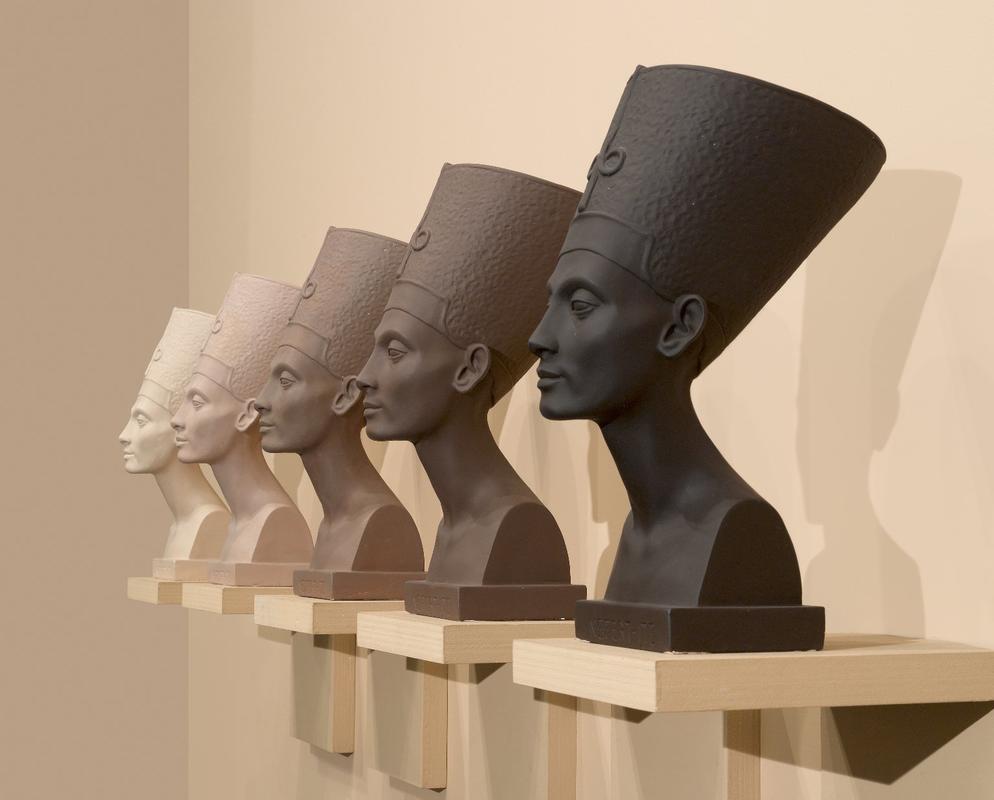More about Grey Area (Brown version)

Contributor
You may recognize Egyptian Queen Nefertiti in Fred Wilson’s Grey Area (Brown version).
The pieces in this work are modeled after a sculpture made 3000 years ago of Queen Nefertiti, the Great Royal Wife of Pharaoh Akhenaten and the step-mother of King Tut. The original, housed in the Egyptian Museum of Berlin, was made by the court sculptor Thutmose in 1340 BC. It was found in almost perfect condition in full color, which is part of the reason why it is one of the most famous pieces of ancient Egyptian art. The other part of the reason is because Nefertiti is objectively, classically beautiful. There isn’t really any denying it. CT scans in 2009 indicated that there may be a wrinkly old woman with a bump on her nose beneath this beautiful woman, but art history has been kind to Nefertiti, and we are left with the younger, less bumpy version.
So Wilson’s versions of Nefertiti in the Brooklyn Museum play with the queen’s image and raises questions of the race of ancient Egyptians. Apparently in 1840 a bunch of American white guys were trying to defend the honor of the Atlantic slave trade (way to pick a cause you guys…) and claimed that Egyptians were in no way related to Africans, essentially whitewashing Egypt despite the fact that it was a racially diverse and metropolitan area.
Wilson is here to make sure that their racism doesn’t continue on. He bought five of the same replicas of the Nefertiti bust and painted each of them five different colors ranging from “oatmeal to dark chocolate.” His point is that each of these Nefertitis individually would not make any sort of statement about the race of ancient Egyptians. All of the sculptures together, on the other hand, hint at all sorts of different theories about them as a people. Wilson explained, “I use beauty as a way of helping people to receive difficult or upsetting ideas. The topical issues are merely a vehicle for making one aware of one’s own perceptual shift—which is the real thrill.”
Sources
- "Grey Area (Brown Version)." Brooklynmuseum.org. N.p., 2008. Web. 8 Oct. 2018. https://www.brooklynmuseum.org/opencollection/objects/5046
- Lee, Jessica. "Queen Nefertiti Dazzles The Modern Imagination – But Why?." the Guardian. N.p., 2015. Web. 8 Oct. 2018. https://www.theguardian.com/science/2015/aug/15/queen-nefertiti-tomb-mi…
- "Nefertiti." HISTORY. N.p., 2018. Web. 8 Oct. 2018. https://www.history.com/author/history
- "Nefertiti: (Society For The Promotion Of The Egyptian Museum Berlin)." Egyptian-museum-berlin.com. Web. 8 Oct. 2018. http://www.egyptian-museum-berlin.com/c53.php











